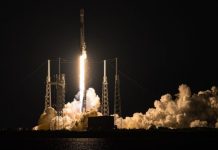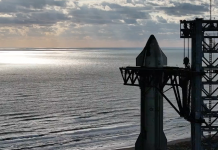It’s getting cramped in orbit: OneWeb and SpaceX satellites nearly collided
Two satellites from the fast-growing constellations OneWeb and SpaceX Starlink dodged dangerous convergence with each other in orbit over the weekend, according to representatives of the US Space Force and OneWeb. This is the first known collision avoidance event between two rival companies seeking to create new space broadband networks.

On March 30, five days after OneWeb launched its next batch of 36 satellites with the Russian Soyuz-2.1brocket, the company received several “red warnings” from the 18th space control squadron of the US space forces about a possible collision with satellite Starlink. Since the OneWeb constellation’s working altitude is much higher (about 1200 km from the surface of the Earth), during the withdrawal, the devices must pass through the SpaceX Starlink satellite network, which rotates at an altitude of about 550 km.
One warning from the US Space Force pointed to a 1.3% chance of a collision: the two satellites approached up to 60 meters – dangerously close by satellites’ standards in orbit. If a collision occurs, it could cause disaster: hundreds of debris could damage the following satellites.
Currently, no national or global body would compel satellite operators to take action in the event of predicted collisions. Following urgent warnings from the US Space Force, the OneWeb and SpaceX Starlink teams had to coordinate satellite maneuvers via email.
According to OneWeb spokesman Chris McLaughlin, in coordination with OneWeb, SpaceX turned off its AI-powered automated collision avoidance system and allowed OneWeb to remove its satellite from the route. It was unclear exactly why SpaceX decided to shut down the system – the company is not commenting on the story.
SpaceX’s automated collision avoidance system has previously raised concerns with other satellite operators, who say they have no way of knowing which way the system will move the Starlink satellite in the event of a close encounter. “The problem is coordination,” says Mr. McLaughlin. “It’s not enough to say,“ I have an automated system, ”because the other side may not have such a system and will not understand what yours is trying to do. ”
SpaceX has roughly 1,370 Starlink satellites in orbit and is preparing to launch thousands more, possibly tens of thousands in the future. So far, OneWeb has launched 146 satellites out of approximately 650 that it has planned for a similar global network operating in higher orbits. Jeff Bezos’ Amazon has pledged to join the race and plans to launch more than 3,000 satellites into low Earth orbit. China is also hatching such plans.
This event was a good example of how satellite operators need to be held accountable given the constraints of global best practices, ” said Diana McKissock, spokesman for the US Space Force. ” They shared their data, contacted, and I think, in the absence of any global regulation … it was the art of the possible. “
By the way, in September 2019, the European Space Agency (ESA) had to use an evasive maneuver on one of its spaceships at the last minute to avoid a possible collision with the Starlink satellite. The probability of collision was 1 in 1000. This may seem like a minor threat, but NASA usually sends ships to the ISS with a probability of collision of 1 in 100,000. ESA said it had to relocate its satellite because SpaceX did not have an action plan. SpaceX explained that it missed ESA’s emails about this issue due to a “bug” in its communications systems. Overall, it looks like such dangers will become the norm.
The working satellites have thrusters, but some of them fail and cannot be controlled from Earth. They gradually decrease and burn up in the atmosphere, but, being in orbit, they turn into a piece of space debris rotating at a tremendous speed. And if there are thousands of them, this could complicate the launch and exploration of outer space in the future.




